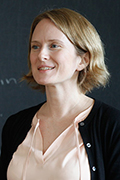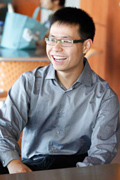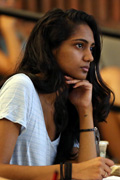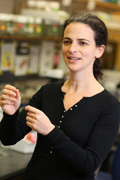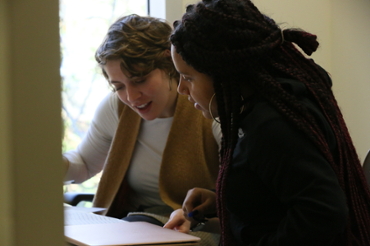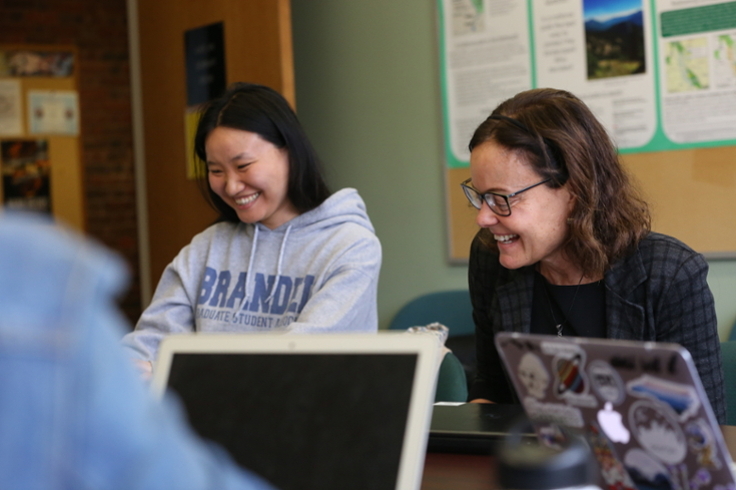PhD Student in Chemistry Investigates Turing Patterns
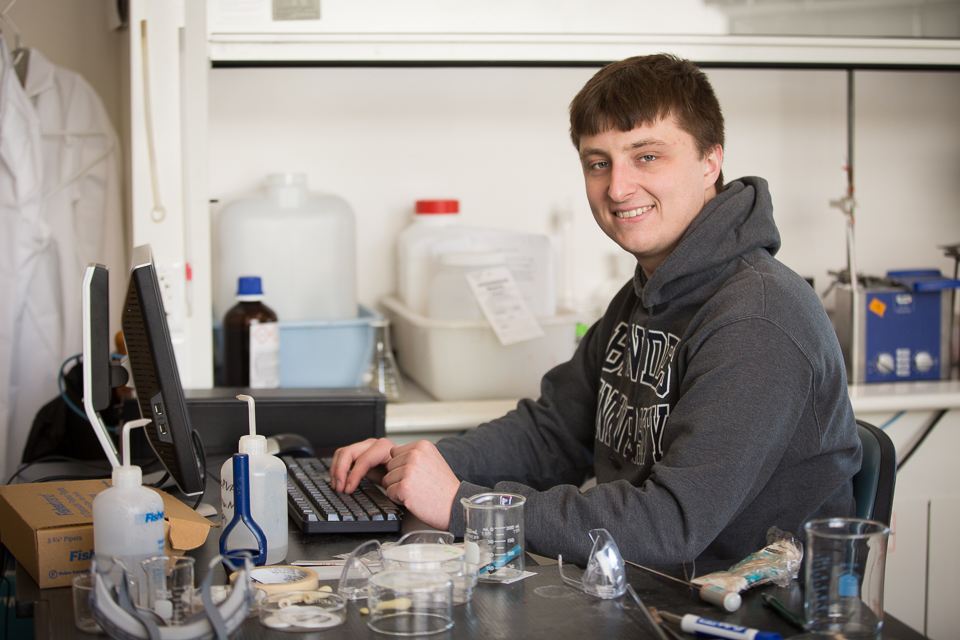
Photo Credit: Simon Goodacre
March 22, 2019
Simon Goodacre | Graduate School of Arts and Sciences
Chris Konow researches the impact of growth on Turing patterns in the Epstein Lab. Turing patterns are named after the British mathematician Alan Turing, who proposed a mechanism for how differentiation can occur within a homogeneous system. The Epstein and Fraden labs at Brandeis have provided experimental support for Turing's predictions and are currently performing research to improve our understanding of the Turing mechanism.
Transcript
Simon:
Hello, and welcome to the Highlights Podcast. I'm Simon Goodacre, the assistant director of communications and marketing for Brandeis University's Graduate School of Arts and Sciences. Today, I'm speaking with Chris Konow. He is a second year PhD student in chemistry, and he's working in Irv Epstein's lab on Turing patterns. Welcome to the podcast, Chris.
Chris:
Thank you, Simon. It's great to be here.
Simon:
So could you tell me what is a Turing pattern? I assume that's named after the mathematician, Alan Turing.
Chris:
Yes, absolutely. So in Alan Turing's one paper on chemistry or mathematical biology, he proposed this mechanism where you start off with a homogenous system, so something like an embryo, where you have a bunch of cells, but all those cells are pretty much the same. But through a random initial perturbation, you're able to get heterogeneity arising. And what that leads to is the formation of a complete organism, where you have lots of differentiated cells in your body. And all of that we think arises from this Turing mechanism, or at least that's the idea behind it.
Chris:
And so there's a couple more things involved. There's a couple of parameters that need to be met, but this is really a way you can start with something uniform and get a non-uniformity arising from that.
Simon:
So as you're thinking of an embryo, everything starts with one cell and then it splits into two and into four and into eight. So this is the process by which those cells go from being identical to being a blood cell or a neuron or something like that?
Chris:
That's what we think, yes, absolutely.
Simon:
And how did Alan Turing's ... He made predictions about this, is my understanding, back in ... well, when he was still alive.
Chris:
Right, right. Now this is like [crosstalk 00:01:49].
Simon:
... six decades ago.
Chris:
Yeah.
Simon:
Could you speak to that a little bit?
Chris:
So yeah, he started out with a very simple, almost just purely chemical model, and all this that takes place is this reaction diffusion processes. And what makes it interesting is the diffusions have to be at a very different ratio. And that's where you were able to get these Turing patterns arising from. And we've seen this a lot in very many different types of animal skin, such as leopard spots, zebra stripes, or numerous different fish, and the fish are what we actually like to do experiments on, if you're a biologist studying this.
Simon:
So I understand that a few years ago, the Epstein and Friedand labs provided some experimental evidence for Turing's predictions, but how are you working with Turing patterns now?
Chris:
Yeah. So in the early 1990s, the first examples of experimental Turing patterns that we were actually able to see that weren't just from simulations of this mechanism, were found in France. And since then, places like France and Texas had been doing those experiments, but it was us here at Brandeis who were able to model them. And so we've been using this model as well as doing our own experiments now to further extend our understanding of the Turing mechanism and what that entails. What I do in particular is I analyze the effect of growth has on these Turing patterns. And growth is so critically important because all biological systems grow. So we need to understand how that plays a role in order to see how these patterns develop naturally.
Simon:
And what materials are you using for the experimentation?
Chris:
So I'm a chemist. I'm in the chemistry department, obviously. And so what we use is a purely chemical system. It's called the CDIMA reaction. CDIMA stands for chlorine dioxide, iodine, and malonic acid. And so what we do with that is we're able to use this experimental system that we've developed over the years, and we are able to, in a thin gel layer, see these Turing patterns. And then because this reaction is photosensitive, we're able to use the light to help grow the system where the Turing pattern was conformed, simulating growth.
Simon:
I see. So nothing, even though it's a simulating an embryo, it's not actually a life.
Chris:
Oh, no. We use chemistry because chemistry is so much simpler than any sort of biological system where there's hundreds and thousands of things happening.
Simon:
Down the road, what are the practical applications for this research?
Chris:
So, as I said earlier, there are so many ways that Turing patterns can be found in nature, whether it's biological or ecological. And so in nature, we need to understand how these patterns grow and how Turing patterns form so we can not only see where those morphologies lie, but we also want to be able to track and then, therefore, somehow to control or redirect the development of these Turing patterns. So if we're able to see where these Turing patterns are coming from and see where this growth is occurring, hopefully we'd be able to find some way to prevent that growth, but in order to prevent something, you need to be able to see where it's coming from. And that's where our research plays a role.
Simon:
Is there an interdisciplinary aspect to the work that you're doing?
Chris:
Oh, hugely, absolutely hugely. Turing patterns, before Turing came up with his mechanisms, this was strictly a mathematical problem and a mathematical biology problem, because they were able to simulate this in tons of different ways. And we simulate it to gain insight into the biology behind it. So as the chemists, we're kind of the middleman where we can take the predictions from the mathematicians, actually see it experimentally, and then hopefully compare that to what you're able to see in organisms that exhibit Turing patterns.
Simon:
And switching gears slightly, working at Brandeis, I wanted to ask you a couple of questions about your experience here. How would you describe the lab environment here?
Chris:
It's honestly better than I could have possibly hoped for coming here. We're such a small, still very liberal-arts-feeling school, and we are able to have so many collaborations, both ... I work with everyone in my lab, but also people in lots of other chemistry labs, physics labs, biology labs, all of those things only possibly because we're such a small school, I think. And plus you're able to go and see any faculty member you want. I say almost everyone has an open door policy, so we're just able to go knock on their door. If they have a minute, you can go in and chat with them about their research. It's really fantastic.
Simon:
With the faculty, how would you describe your experience with them? Do you have any particular mentors on campus?
Chris:
Mentor-wise, Irv's obviously my PI, so he does a lot of mentoring, but I also work with this project in particular with Milos Dolnik, who is the general chemistry lab head guy. And he has been doing the system for years. So we're able to do some research there and he's definitely, really mentored me a lot over the past year and a half that I've been here.
Simon:
And a couple more questions for you. I understand that you are a fellow in our CommLab with Anique Olivier-Mason. What inspired you to become a fellow and what is the experience been like?
Chris:
The experience has been very positive. I wanted to be a fellow because it is something, science communication. You can't just have science for scientists. Science needs to be able to be understood for everyone, including the general public. And that's how you're going to influence policy, is if everyone is on the same page. And so I wanted to join the CommLab because of a lot of professional development and also working with people who want to communicate their science, but don't know how. And that's really what we focus on, it's making sure we reach the audience that you want to reach, not just the audience in your own head.
Simon:
And a final question. I've got to ask you the perennial favorite. Do you have any plans yet for what you're going to do after Brandeis or is it still a bit early?
Chris:
Oh, in my second year, I still got a couple of years left. I'll give that thought a little down the line.
Simon:
Fair enough. Fair enough. Well, Chris, thank you so much for making time for this.
Chris:
Well, thank you for having me.
Simon:
You're very welcome and listeners, we hope you'll join us next time on the Highlights Podcast.
